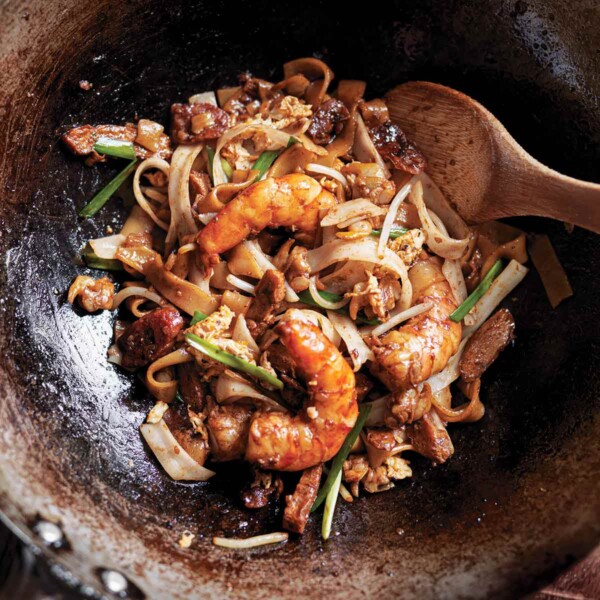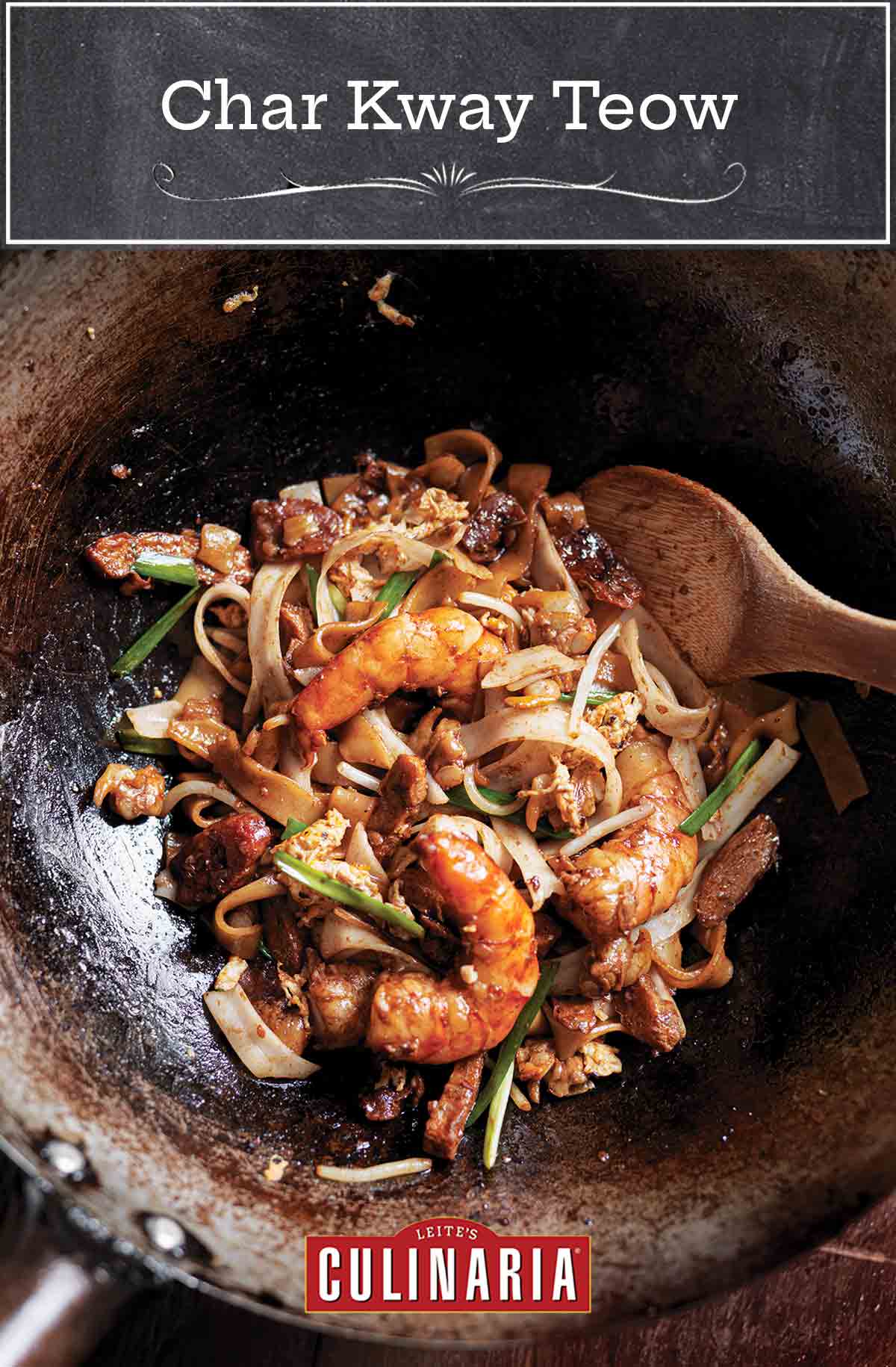
Char kway teow, considered one of the national dishes of Singapore, is also a popular street-hawker dish in Indonesia, Malaysia, and Brunei. Traditionally it’s stir-fried in lard and topped with an unusual type of cockle bursting with dark red juices known as a blood cockle, but I’ve used peanut oil to be a bit healthier and normal clams as you can’t get blood cockles here for love or money. Wok hei (the “essence” imparted by a hot wok during stir-frying) is important for this dish—in fact, I recommend cooking each portion separately to ensure optimum flavor and texture.–MiMi Aye
WHAT DO I LOOK FOR IN THE ASIAN INGREDIENTS FOR CHAR KWAY TEOW?
Here’s what the author suggests in terms of what to look for when sourcing the ingredients in the recipe:
Peanut Oil
I use peanut oil for all my cooking. It heats well, deep-fries beautifully, and has a clean, neutral taste. If you’re allergic to peanuts, feel free to substitute a neutral-flavored oil that can be used for frying.
Rice Noodles
Broad, flat rice noodles—aka ribbon noodles—are used across Asia where they are generally known by the Chinese names of ho fun and chow fun. Think of them as the rice version of tagliatelle. Slightly chewy in texture. Found either fresh in strips or sheets that can be cut to the desired width or dried in packages. Kway teow is also a flat, broad noodle, used mainly in Malaysia and Singapore, that’s found fresh in strips or sheets that can be cut to the desired width or dried in large shrink-wrapped bundles in Asian supermarkets. Differs from ho fun in that kway teow is technically made from rice cakes sliced into strips and is therefore slightly stiffer than ho fun, but the two are interchangeable in most recipes.
Chinese Sausage (Lap Cheong)
Dried, fatty, sweet, chewy sausage that is usually sold in bundles. Typically called for in preparations that involve frying.
Fishcake (Kamaboko)
A readymade bouncy mash of fish and rice flour or wheat flour that can be sliced and fried.
Light Soy Sauce
I’m quite picky about the brand I use (Pearl River Bridge Superior Light Soy Sauce) and suggest you use the same.
Dark Soy Sauce
Mostly used to add color and sweetness in cooking

Char Kway Teow
Ingredients
- 2 1/2 ounces dried or 7 ounces (200 grams) fresh broad, flat rice noodles (also known as ribbon noodles, ho fun, or kway teow)
- 6 to 8 tablespoons peanut oil
- 2 cloves garlic, finely chopped
- 1 Chinese sausage (lap cheong), thinly sliced at an angle
- 8 large raw shrimp, peeled and deveined
- 1 3/4 ounces ready-made fishcake, sliced into strips (you’ll find this in the refrigerator or freezer aisle at Asian grocery stores or substitute more shrimp; this is NOT breaded fish sticks)
- 1 3/4 ounces mung bean sprouts, topped and tailed
- 2 tablespoons light soy sauce, (the author recommends Pearl River Bridge Extra Virgin or Superior Light)
- 2 teaspoons dark soy sauce, (the author recommends Pearl River Bridge Superior Dark)
- 2 teaspoons Indonesian sweet soy sauce, (known as kecap manis; the author recommends Healthy Boy) or 2 teaspoons light soy sauce mixed with 1 teaspoon light brown sugar
- 2 teaspoons chile sauce, (Sriracha is particularly good)
- 6 tablespoons water
- 2 large eggs
- 2 garlic chives or scallions, thinly sliced or cut into 1-inch lengths
- 3 1/2 ounces shelled fresh cockles, (or substitute fresh shelled clams or, if you’re feeling indulgent, lump crabmeat)
- White pepper, to taste
Instructions
- If using fresh noodles, carefully separate them (they should come apart in strands), then set them aside, lightly covered with a damp cloth or plastic wrap. If using dried noodles, prepare them according to the package directions or place them in a large heatproof bowl and add enough boiling water to cover. Let rest until bendable, 6 to 10 minutes. Drain in a colander and rinse thoroughly under cold running water and drain again. (Depending on the type of rice noodle, you may need to repeat to get the noodles sufficiently bendy.)
- You need to cook the char kway teow 1 portion at a time for the best results. Before you do anything else, measure out all the ingredients in two portions and have them at the ready next to the stove because once you start this stir-fry, there’s no time to stop and measure. Heat a wok on high heat until you can feel the waves of heat coming from it with the palm of your hand (this is known as “wok hei”). Add 2 tablespoons oil, half the garlic, and half the Chinese sausage and stir-fry constantly until the garlic is fragrant and the sausage is glossy, 1 to 2 minutes. You want to watch that garlic so you catch it before it scorches and imparts a bitter flavor to the entire dish.
- With the heat still on high, add 4 shrimp and half the fish cake and stir-fry for another couple minutes until the shrimp turn pink. Turn the heat down to medium and push everything to the side of the wok, then add half the noodles and bean sprouts, half of each sauce, and 3 tablespoons water to the cleared space. Mix these new ingredients together, then stir-fry for 2 minutes in the cleared space.
- Now push everything to the side of the wok again. Add 1 tablespoon oil to the cleared space and, when it’s hot, crack in an egg. Break up the egg with your spatula, then pull everything back into the center of the wok and combine well with the egg. If the mixture seems dry or is sticking to the wok, add 1 tablespoon oil.
- Add half the chives or scallions and white pepper to taste and stir-fry to combine well. Lastly, add half the cockles or clams and stir-fry for 30 seconds. Turn the noodle concoction onto a plate and serve immediately with chopsticks. Repeat with the remaining ingredients for the other portion.
Nutrition
Nutrition information is automatically calculated, so should only be used as an approximation.
Recipe Testers’ Reviews
If you like pad Thai, you’ll love this recipe. Char kway teow has textures and flavors that are very similar, although this is much more rustic and rich in flavor. I am excited to make and share this with my guests and family again. This was definitely a Leite’s Testers’ Choice recipe due to the rustic appeal and the intense flavor profile of the interesting ingredients. I love street food made with basic ingredients found locally around the world. This dish gave me a very satisfying feeling of comfort. It was easy enough to find most of the ingredients at one of my local Asian stores, and I bought the seafood at a local fish market (I substituted fresh shelled clams for the cockles).
My tasters loved the rich flavors, and the nice (but not too spicy) heat of the chile sauce. The clams added great flavor along with some nice texture. If you don’t like the taste of clams, just leave them out and add more shrimp instead.
It’s important to have all ingredients prepped and ready in order of the stir-fry process. It takes about 10 minutes to complete the entire stir-fry.
I used dried rice noodles because I had them in my pantry. I’d like to try the fresh ho fun noodle next time. The dried noodles came in a 14-ounce pack, and I used all of them instead of the 200 grams (7 ounces). Seemed like it was better with more noodles per batch because of the amount of oil and soy sauce suggested.
I thought the amount of soy sauce was just on the edge of being too salty. That said, I may tweak or leave out the light soy sauce. I used Kikkoman (light), Pearl River Bridge Superior Dark Soy Sauce, and Kwong Hung Seng Sauce Sweet Soy. I also used Dynasty brand Thai Chile Garlic Paste instead of Sriracha, along with a dash of white pepper.
I thought the 8 tablespoons peanut oil sounded like too much, but it’s definitely just the right amount to keep the noodles moist enough and avoid sticking and scorching in the pan. The noodles absorb the oil and become a bit chewy and sticky. I had fresh spring chives in my garden, so I used those instead of scallions.
This is a terrific street noodle dish that can be on your table in under half an hour. The combination of mixed seafood and sweet Chinese sausage tossed with noodles in a savory and slightly sweet sauce with as much or as little chile heat as you like is irresistible. The technique in this recipe is spot-on—just make sure your wok is hot enough. The technique of pushing everything up the side of the wok worked just fine for me. (If the odd piece of shrimp slides back down, don’t worry about it.)
As written, the spice level in this recipe is mild. Up the chile sauce if you want more heat. I’d also up the number of garlic chives a bit, but I really like garlic chives. I made this recipe again last night with the lump crabmeat substitution in place of cockles. Awesome. This was definitely an improvement—sure, not traditional, but really, really good. Hell, how can adding crabmeat to something be bad? I also upped the chile sauce just a tad—not by much at all, just a tiny squirt more to give the dish more heat.
I used the option of dried rice noodles for this recipe, buying the widest I could find. They were about 1/2 inch wide. The author of this recipe is based in the UK, where you can get cockles much more easily than in the US, and you can get them already shelled. I opted for frozen cockles from my Asian market, which were still in the shell, but because they were cooked before freezing, the shells opened up easily. Even better, these were the actual blood cockles that are traditional for this dish. Since the cockles go into the stir-fry at the very end, the fact that they’re pre-cooked isn’t an issue. If you’re buying cockles in the shell, whether fresh or frozen, you’ll need about 500 grams of cockles to get the 100 grams meat for this recipe.












Hi David,
I think it’s quite legitimate to say that Char Kway Teow does have a Singaporean association. 🙂 The concept of wok-fried flat rice noodles (that’s the literal translation from the Hokkien/Teochew dialect) is intrinsically Chinese, and was brought to the British colonial Straits Settlements (of which Singapore, Malacca and Penang were part of) by South Chinese immigrants. So it was just a matter of time before each part evolved its own version of the dish – the concept of “same-same, but different”! As far as I have sampled – and I’ve eaten A LOT of the dish growing up in Singapore and spending a lot of time in Penang and other parts of Malaysia with a significant Chinese population, the one key ingredient is the cockles! And it MUST be fried in lard for that fabulous flavour! But I always ask for extra beansprouts and chilli paste in, for crunch and heat.
Say “char kway teow” to any true-blue Singaporean or Malaysian, and first we get all nostalgic, and then we get all argumentative about where the best is, what style, etc etc etc… 😀
Ling, thanks for adding a historical perspective to this wonderful dish!
Wait a minute… Char Koay Teow is a national dish of Singapore???? Seriously?? What hawker food has Singapore not stolen from Malaysia and pawned off as their own?? Singapore was part of Malaysia a long time ago. That’s where all it’s hawker foods originated from. Ask any Singaporean chinese old timer where to go for the best hawker foods and they themselves will tell you that Penang and Ipoh is Hawker food haven.
Thanks for the input, Julian.
Ah. First the carrot cakes. Now this. I am hungry for home and shouldn’t have turned to the Internet.
We can understand why you’d be hungry for home, Anivyl! Would love to know which source you turn to for recipes when you get the craving for homestyle food…
Haha, my source of recipes ranges. Most of them are from this blog called Rasa Malaysia, but others can be from friends sharing recipes on Facebook and also food blogger ieatishootipost (who mostly review local foods but does have recipes like cereal prawns ons his site).
My recipe collection is like that, too, Anivyl—from wherever I can find something worth my while. Greatly appreciate you sharing these sources, I’m off to check them out right now!
I forgot to mention an interesting tidbit. It’s interesting because here you are talking about how to cook char kway teow but just a few days ago, a few people mentioned how traditional local street foods are dying out. Not just from lack of people wanting to work in the industry but also locals themselves being so spoilt for choices some of the teens have yet to have eaten char kway teow.
Completely agree that much true and authentic fare, include street food, is being lost due to the emphasis on convenience as well as the relative availability of formerly foreign things that have evolved, Anivyl. And what a loss. Best not to get me started on the topic…